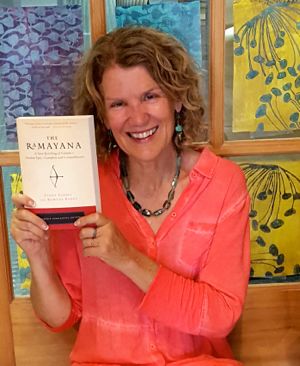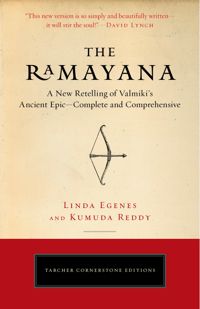by Linda Egenes
I’m not a Ramayana scholar or a Sanskrit expert.
But I love a great story, and back in the late 1970s when I first met my husband, Tom, he told me some of the romantic stories from the Ramayana epic from India, and of course, I had to read it myself.
Struck with the Magic of an Ancient Epic
I was struck by the spiritual depth of this ancient epic. Here was a story about an enlightened hero and heroine who faced human challenges of loss, betrayal and separation from loved ones.
As in all great literature, they were pressed to their limits. The fact that they could endure these challenges while still treating each person (and creature, for that matter) they met with dignity, respect and compassion was such a moving lesson for me.
Forgiveness, perseverance and compassion are all important themes in the Ramayana.
Bringing an Eastern Spiritual Guide to the Western World
Much later, when I was teaching writing and writing articles about meditation and healthy living for various publications, Kumuda Reddy, M.D., asked me to collaborate with her on three books about Ayurveda, the natural, preventive system of traditional healthcare from India.
In our book Super Healthy Kids: A Parent’s Guide to Maharishi Ayurveda we mentioned that it’s healthy for children to have good role models. And the Ramayana provides that.
It’s the most widely read epic in history, considered a spiritual guide by over a billion people in India today. My co-author, Kumuda Reddy, grew up learning these stories from her grandmother, and like most children in India, Rama and Sita are her role models.
Our idea was to retell the story in English for the Western reader, in a way that honored the spiritual depth of the original, but was shorter than the original and used novelistic techniques to hold the modern reader’s attention.
Many Times I Wanted to Give Up
I think almost anyone who has written a book has felt at some point that they just can’t see it through.
Kumuda and I started this retelling 18 years ago, and writing the first draft in the first year-and-a-half our journey was an amazingly joyful experience.
But with the changes in the publishing industry in the last two decades, this manuscript was orphaned, which was sad for us, because in many ways, it was dearest to our hearts.
There were many times during those 18 years that I wanted to give up on this project. It takes a tremendous amount of effort to bring a 450-page manuscript to publication quality, especially when you are also trying to make a living writing and also juggling caring for your aging parents, teaching, etc.
For years at a time I would despair that any publisher would ever want to publish it, or that anyone would buy it if we self-published. I think anyone who has written a book can identify with these feelings.
Perseverance is the Source of Success and Happiness
At times like those, I took heart from the Ramayana itself.
Perseverance is a big theme in the epic, and there are so many times when the main characters lose heart and a companion reminds them that the only way to succeed is to keep going.
Hanuman, one of the major characters, says, “Perseverance is the source of success and happiness.”
For me, it was my husband who kept me going whenever I would lose faith. He also helped us immensely by adding the translated Sanskrit verses at the end of each chapter.
A professional editor also brought the book to a much higher level. Slowly, over the years, it evolved into a better and better manuscript.
Am I Qualified to Write This Book?
I think for me the biggest emotional challenge was wondering why I was qualified to write this book.
I mean, I loved the story and felt deeply moved by it, but, as I said, I am not a Sanskrit scholar or translator, nor is my co-author.
The Ramayana has been beloved for thousands of years, and over a billion people in India today consider it to be their spiritual guide. Even though I feel a deep connection to this story, I did not feel worthy of being its co-author.
Once it was published, this self-doubt came acutely into play because now I was going to have to speak about it to live audiences both in person and on the radio. I went through such a crisis that I got physically sick with a bronchial infection that constricted my throat and made it impossible to speak with out coughing violently.
I Realized All I Had to Be Was Myself
Fortunately I looked deep inside and had a realization that I didn’t have to be a Sanskrit scholar or an Indian or anyone special to speak about the Ramayana.
All I had to be was myself—and to talk about my personal connection with the Ramayana, what it meant to me.
I have practiced the Transcendental Meditation technique for the past 45 years, and I feel deeply connected to the spiritual tradition that the Ramayana springs from. The stories of yogis and sages who live deep in the forest and help guide Rama and Sita on their journey are deeply moving to me.
And I realized that by sharing my connection, it could open a discussion for others to form their own personal relationship with this beautiful epic.
 When the Manuscript is Truly Ready, the Publisher Will Come
When the Manuscript is Truly Ready, the Publisher Will Come
The biggest triumph in writing the book was not during the process but in securing our publisher.
About three years ago we had decided to self-publish, and a talented friend was already working on the book cover and design when my husband and his co-author, Dr. Vernon Katz, landed a contract with TarcherPerigee, an imprint of Penguin Random House, for their collaboration, The Upanishads: A New Translation.
I realized that our book would fit into the same Tarcher Cornerstone Classics line of world literature. So once Tom and Vernon signed the contract, I queried their editor and he immediately replied that, yes, he wanted to see the manuscript. He kept it for a year, but when he finally read it, he accepted it in four days.
And he said, “I don’t want you to make any substantial changes—just normal copyediting, grammar, etc.”
That was an astounding moment, that all the work and love that we had poured into this manuscript for 18 years, blindly forging ahead, had somehow become something complete and whole and ready to go.
It was a great moment of affirmation for me, a real “If you build it they will come” kind of moment (from the movie Field of Dreams).
It completely changed my perspective on publishing. I realized that I needed to stop worrying about finding a publisher for my manuscripts and instead spend all my energy in making each manuscript the best it possibly could be.
When the manuscript is truly ready, the publisher will come.
In Writing the Book, I Learned Lessons of Compassion and Forgiveness
The Ramayana is not a dusty old tome. It’s a living inspiration to over a billion people today in the East, and is just now gaining a wider readership in the West.
It contains not only spiritual wisdom but inspiration about human relationships. It’s not only a prescription for how to live life—it gives us the vision of what is possible for human development.
There are many examples of Rama and Sita’s compassion throughout the story. At the end of the story, when Sita is finally released from captivity, a friend suggests that the demon women guards, who have tormented her for months, should be put to death.
But Sita says, “ It would be wrong to punish these women, because they are slaves who must follow the orders of their ruler, and some have been kind to me . . . . It is never right to answer evil with evil. The jewel of the virtuous is their good conduct. The virtuous are compassionate to all, even criminals who are sentenced to death. For who is so perfect that he can say he is without fault?”
As another example, Rama, the central figure of the story, is beloved by all for his gentle, truthful and benevolent nature. He is incredibly forgiving to everyone he meets, even his enemies.
One of the most telling moments happens at the climax of the story when Rama finally destroys the horrific demon Ravana, his greatest enemy, who has kidnapped Rama’s innocent wife without provocation.
Instead of exulting in his great feat, Rama quietly consoles Ravana’s brother by saying, “Death quells all enmity. We have achieved our purpose. Perform his rights with honor, for he is as dear to me as he is to you.”
I remember these lessons of compassion and forgiveness and try to apply them to my own life.
I Wanted to Write from a Settled Mind and a Flowing Heart
I would say that working on this story—creating a modern version of the ancient Ramayana epic for today’s readers—was certainly a spiritual practice, and I took this endeavor very seriously.
Before each writing session, I would make sure that I was rested, that I spent enough time to do my full Transcendental Meditation practice twice a day, that I ate foods that would give me a clear mind.
I wanted to write from a settled mind and a flowing heart, and I relied on my twice-daily TM practice to help me with that. It was a very joyful, focused and evolutionary time, working on this manuscript.
I felt that I was transformed, and I feel honored and grateful to have had this opportunity. I especially want to thank my co-author, Dr. Reddy, who had the inspiration to do this work and asked me to join her.
For me, writing is a way of transcending with my eyes open. It’s a way of discovering and unfolding my innermost thoughts and prayers for the world. It’s a way of being my best self and letting it shine.
So yes, I would say that writing novels, writing anything, is for me a spiritual practice.
Story Reveals Deep Truths of Life
[What’s next?] I am near completion of a young adult novel about an Amish girl growing up during World War II, when the Amish were vilified for being of German descent, even speaking German at home, but were conscientious objectors because it is against their faith to kill another human being even in self-defense.
It has themes of war, peace, and faith weaving through it, and grew out of a collection of essays I published with University of Iowa Press in 2010, Visits with the Amish: Impressions of the Plain Life.
I met an Amish girl while researching the book who became the inspiration for my heroine, Ida Mae.
For me, structure is my biggest challenge. In retelling the Ramayana, the story questions, conflict, and turning points were already set, so I could focus on other aspects of storytelling such as voice, language, pacing, scene setting and keeping the reader turning the pages.
This project is more challenging for me because I have to generate the entire thing myself. But I am fascinated by the way story reveals deep truths of life, and by delving into the mechanics of storytelling I am learning so much about myself and my relationship to others.
It’s another step in my personal journey, and I am looking forward to the lessons it reveals.
(Read more about Linda on her previous Writing and Wellness post.)
Photo credit: Cheryl Fusco Johnson (photo of Linda with her book) and Juliet Jarmosco (bio photo).
* * *
 Linda Egenes is the author of more than five hundred articles about the benefits of meditation, yoga and healthy living. She is the author of Visits with the Amish: Impressions of the Plain Life, and with Kumuda Reddy, MD, she co‑authored three books on Maharishi Ayurveda for children and families as well as All Love Flows to the Self: Eternal Stories from the Upanishads.
Linda Egenes is the author of more than five hundred articles about the benefits of meditation, yoga and healthy living. She is the author of Visits with the Amish: Impressions of the Plain Life, and with Kumuda Reddy, MD, she co‑authored three books on Maharishi Ayurveda for children and families as well as All Love Flows to the Self: Eternal Stories from the Upanishads.
A practitioner of the Transcendental Meditation technique since 1971 and a certified teacher, Linda is an adjunct associate professor of writing at Maharishi University of Management in Fairfield, Iowa, where she lives with her husband, Sanskrit scholar and author Thomas Egenes. She can be reached at her blog and website, www.lindaegenes.com.
 The Ramayana: A New Retelling of Valmiki’s Ancient Epic by Linda Egenes and Kumuda Reddy: An abridged and page-turning rendition of the ancient Indian epic of loyalty, betrayal, redemption, and insight into the true nature of life.
The Ramayana: A New Retelling of Valmiki’s Ancient Epic by Linda Egenes and Kumuda Reddy: An abridged and page-turning rendition of the ancient Indian epic of loyalty, betrayal, redemption, and insight into the true nature of life.
One of history’s most treasured ethical and spiritual works, it’s a grand, sweeping epic of the divine bowman and warrior Rama, who is unjustly exiled to the forest on the day he is be crowned king and must battle the greatest forces of darkness on earth when his beloved wife Sita is stolen by the demon king.
Sometimes described as the Bible, Star Wars and Romeo and Juliet rolled into one, the Ramayana is one of the foundations of world literature and is the most widely-read epic in the world today.
Available at Penguin/RandomHouse and at Amazon.


Thanks for sharing, Linda. It’s good advice for my rather long project, now finally going to the editors.
I love “All Love Flows To The Self” you co-authored with your husband and Dr. Reddy – beautifully told stories from the Upanishads. So I very much look forward to reading this.
Thanks for the sustained effort.
Dear David B.,
Thanks so much for your kind words about my blog post and my earlier book co-authored with my husband and Kumuda Reddy, All Love Flows to the Self. I wish you lots of luck (and persevering power) for your project. So wonderful that it is going to the editors now–congratulations! It sounds like you’re almost there.
Best wishes,
Linda
Linda, This writer/poet seeker girl has been inspired and uplifted by this post so shall definitely be reading your newest book. Thank you, thank you. This was just wat I needed to read to help me keep afloat on my own memoir/seeker/spiritual journey project.
Dear Meg,
Wow, I am a great admirer of your poetry and writing, Meg! So it’s wonderful to hear that I have inspired you back. Best wishes with your memoir/seeker/spiritual project. I can’t wait to read it.
Best,
Linda